Time 22:43 Date 24 May 2001 Injuries 380 | Non-fatal injuries 380 Number of deaths 23 | |
 | ||
Cause Insufficient load capacity due to flawed structural design Similar Collapse of Hotel New World, Collapse of the Royal Plaza Hotel, Maccabiah bridge collapse | ||
The Versailles wedding hall (Hebrew: אולמי ורסאי), located in Talpiot, Jerusalem, Israel, is the site of the worst civil disaster in Israel's history. At 22:43 on May 24, 2001, during the wedding of Keren and Asaf Dror, a large portion of the third floor of the four-story building collapsed. As a result, 23 people fell to their deaths through two stories, including the groom's 80-year-old grandfather and his three-year-old second cousin, the youngest victim. Another 380 were injured, including the bride who suffered serious pelvic injuries that required surgery. Asaf, who escaped serious injury, carried her in his arms from the rubble.
Contents
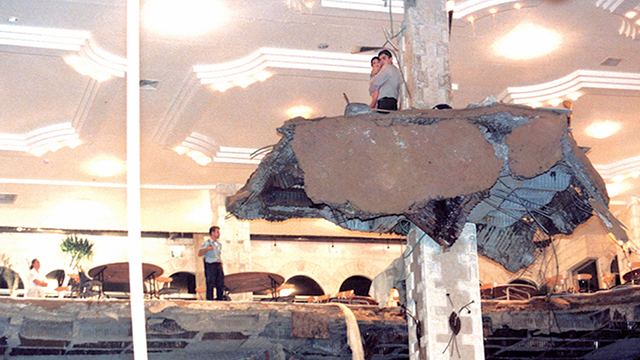
The disaster shocked the Israeli public not only because it was one of the worst building disasters in the country's history, but because the event was documented on a camcorder and broadcast on local and international television.
Rescue efforts
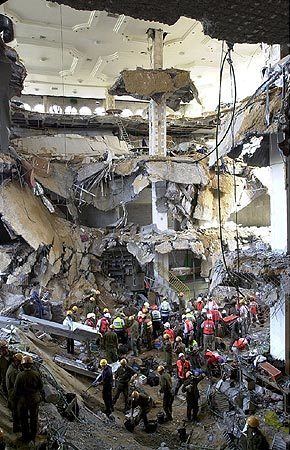
Rescue efforts were carried out by the Home Front Command's Search & Rescue Unit and the Yachtza reserve unit. Rescue efforts commenced immediately after the collapse and continued until 4pm on Saturday May 26, 2001. Three people were pulled from the rubble alive and 23 bodies were removed.
Investigation
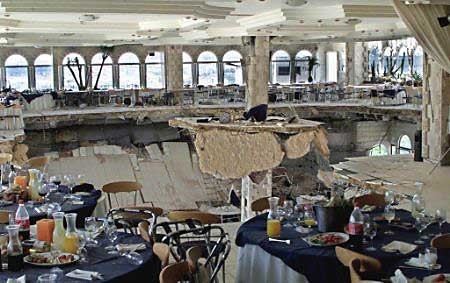
An investigation of the event concluded that the event was not caused by a terrorist attack. This was based on the testimony provided by many of the wedding guests present in the building during the disaster. Witnesses reported seeing a dangerous sag in the floor moments before the collapse. An initial inquiry blamed the collapse on the Pal-Kal method of constructing light-weight coffered concrete floor systems which was already banned before the completion of the wedding hall after it was known and proven to be unsafe. Further review pointed to a combination of two alternate causes.
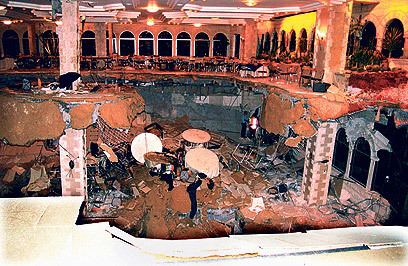
Initially, the side of the building that failed was designed to be a two story structure, while the other side was designed to be three stories. Late in the construction process, it was decided that both sides of the building should be equal heights, and a third story was added to the shorter side. However, the live load due to occupancy is typically much greater than the design load for a roof. As a result, the structure supporting the new third story was subjected to much greater loading than was originally anticipated. The effect of this error was somewhat mitigated by the construction of partitions on the floor below, which helped redistribute the excess load well such that no damage was incurred.
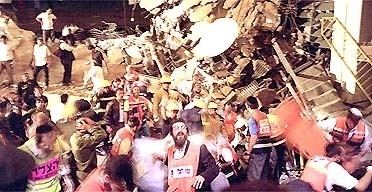
A few weeks before the collapse, the wedding hall owners decided to remove the partitions. With the load path eliminated, the floor above began to sag several inches. The owners viewed the sagging floor primarily as a cosmetic problem, and attempted to level it with additional grout and fill. However, their approach not only failed to provide additional structural capacity, it also inadvertently introduced a new and significant dead load at the weakened area.
During the wedding event in 2001, this significantly overstressed floor section failed, resulting in the catastrophe. The engineer Eli Ron, inventor of the Pal-Kal method of construction, was arrested and subsequently indicted in August 2002 on the charge of manslaughter. Ron had not engaged in any part of the design or construction, but had sold proprietary elements necessary for construction that were installed in a deficient manner.
Versailles Law
Following the disaster, the "Versailles Law" was passed by the Parliament of Israel. This law established a special committee responsible for treating the people injured in the disaster. Moreover, an official investigation committee was established under the leadership of the former judge Vardimos Zeiler, who was in charge of the security of public places and buildings.
In October 2004, the three owners of Versailles wedding hall — Avraham Adi, Uri Nisim, and Efraim Adiv — were convicted of causing death by negligence and causing damage by negligence. Adi and Adiv were sentenced to 30 months imprisonment while Nisim was sentenced to four months of community service.
The wedding hall was subsequently demolished, and as of 2007 the site remained unoccupied and sealed. Across the street from the site is a memorial garden with names of victims inscribed on a wall.
In May 2007, Eli Ron and three engineers involved in the building's construction were sentenced to prison by the Jerusalem District Court. Eli Ron received a four-year sentence, Shimon Kaufman and Dan Sheffer 22 months, and Uri Pessah six months. In December 2006, the court had convicted all three men of causing death by negligence and sabotage by negligence.
Memorial
A memorial garden to the victims was built near the disaster site.
